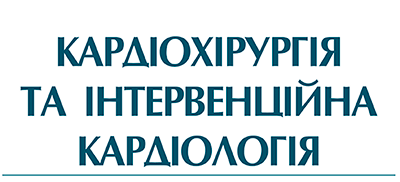Original research
DOI: http://doi.org/10.31928/2305-3127-2019.4.1520
State of intracardiac and central hemodynamics in patients with mitral valve insufficiency during surgery with cardioprotection by electrical fibrillation and intermittent aortic clamping
B.M. Todurov 1, 2, Yu.A. Kharenko 1, 2, M.V. Khartanovich 1, V.B. Demyanchuk 1, 2, I.Yu. Mokryk 1
1 Heart Institute, Ministry of Health of Ukraine, Kyiv, Ukraine
2 Shupyk National Medical Academy of Postgraduate Education, Kyiv, Ukraine
The aim – to evaluate the state of intracardiac and central hemodynamics in patients with mitral valve insufficiency during surgery with cardioprotection by electrical fibrillation and intermittent aortic clamping.
Materials and methods. We examined 45 patients with mitral valve insufficiency admitted for surgery of the defect. All patients underwent mitral valve replacement, and the local protocol оf the protection of myocardium was performed by applying electrical cardiac fibrillation and intermittent clamping of the aorta. Left ventricular end systolic, end diastolic and stroke index, ejection fraction, as well as cardiac index, pulmonary artery systolic pressure and global longitudinal myocardial strain were determined at the end of the сardiopulmonary bypass, before being transferred to intensive care unit (ICU) and after leaving ICU.
Results. The end systolic index was not significantly altered during the study stages. At the same time, end systolic index gradually decreased and, before being transferred from ICU, became significantly lower than the baseline (p < 0.03), although such dynamics did not affect the stroke index. The ejection fraction at the end of сardiopulmonary bypass insignificantly increased to 53.6 ± 4.1 % and then remained almost at the same level: 53.2 ± 5.4 % before being transferred to the ICU and 54.2 ± 6.2 % before transfer from ICU. The global longitudinal myocardial strain module at the end of the сardiopulmonary bypass significantly (p < 0.003) decreased to –11.9 ± 0.8 %, then gradually returned to the previous level. PPAs after correction of the defect and at the end of сardiopulmonary bypass significantly decreased to 36.8 ± 2.6 mm Hg (p < 0.0001), further, before transferring to the ICU, it became still significantly (p < 0.004) lower. All cardiac index changes during the study were insignificant.
Conclusions. These results indicate that the cardioprotection method used did not have a negative impact on myocardial contractility, central and intracardiac hemodynamic parameters.
Key words: intracardiac hemodynamics, central hemodynamics, mitral valve insufficiency, cardioprotection, electrical fibrillation, intermittent aortic clamping.
| [PDF] | [References] |








